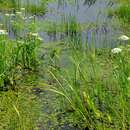Biology
(
英語
)
由Arkive提供
This plant is a perennial, and the flowers appear in July and August. It does not like disturbance, and cannot survive regular cutting or ditch clearance, but can tolerate the occasional slubbing of its ditches and moderate grazing. However, whilst cattle and other stock seem to be immune from the effects of the plant's poison, dairy cows are discouraged from browsing it as it imparts an unpleasant taste to their milk.
Conservation
(
英語
)
由Arkive提供
The greater water-parsnip is listed in the UK Biodiversity Action Plans (UK BAP) and is included in English Nature's Species Recovery Programme. The Environment Agency, who are the lead partners in work to recover this species, have produced plans to improve river and floodplain management that will benefit other plants and animals that are features of these important habitats. If possible, seed from the Millennium Seed Bank, managed by the Royal Botanic Gardens, Kew, at Wakehurst Place, may be used to restore populations of the greater water-parsnip at suitable sites within its former range.
Description
(
英語
)
由Arkive提供
Greater water-parsnip is an upright plant, with a very robust appearance. The stem is hollow and grooved; the leaves, which can grow to 30cm, have stalks, which are also hollow and clasp the main stem. The plant is bright green and hairless. The flowers are white, measure about four millimetres across, and are carried on an umbel, characteristic of this family of plants. One of the alternative English names for this plant is water hemlock, as it bears a close resemblance to hemlock Conium maculatum often found growing on wet meadows and banksides.
WARNING: this plant is also deadly poisonous and contact with it should be avoided at all times.
Habitat
(
英語
)
由Arkive提供
Greater water-parsnip is found in wet ditches on fens and swamps. It prefers still or slow moving shallow water that is not acid and where the soil is peaty or has been deposited by rivers. While it seems able to cope with tall vegetation such as reeds competing with it, it does not like being overshadowed by trees and is not found in wet woodland.
Range
(
英語
)
由Arkive提供
This species is found across most of Europe although it is rare near the Mediterranean region. In the UK, it is found south and east of a line drawn between the River Humber and the Bristol Channel, although it also occurs in good numbers in the Lough Erne system of Northern Ireland.
Status
(
英語
)
由Arkive提供
Classified as Nationally scarce in the UK, and protected under Schedule 8 Wildlife and Countryside Act, as amended.
Threats
(
英語
)
由Arkive提供
As well as being intolerant of disturbance, greater water-parsnip is also threatened by drainage of its sites, and the neglect of ditches, allowing scrub and young woodland to become established.

